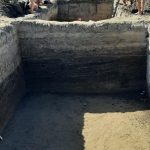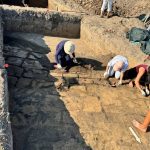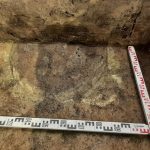Archaeological studies of the Khazar period sites in the Astrakhan region
In July-August 2024, the Institute of Archaeology named after A.Kh. Khalikov of the Tatarstan Academy of Sciences jointly with LLC “Aрхеоцентр” (Astrakhan), Belgorod State National Research University (Belgorod) and Sevastopol State University (Sevastopol) continued archaeological studies under the state program of the Republic of Tatarstan “Preservation of the national identity of the Tatar people” in Privolzhsky and Kamyzyak districts of the Astrakhan region. In the current field season two monuments of Khazar period, located in the delta of the Volga River 20-25 km southeast of Astrakhan, were excavated: Maly Kostyube-1 and Baraniy Bugor settlements.
A structure was excavated at the Maly Kostyube-1settlement, which consists of four trenches from “galleries” deepened into the ground, each about 5,5 m wide. The walls and bottom of the trenches have traces of brick siding, some of them still have masonry, made of burnt bricks, bonded with lime mortar, on top of which there was the so-called “Byzantine concrete”, obtained by quenching lime together with filler – thermally activated clay and brick crumbs. There is an assumption that it was Byzantine architects who built the galleries. The trenches are filled with lime and broken burned bricks, formed as a result of dismantling the building. The size of the structure, established by geophysical methods, is more than 40×100 m. The absence of traces of household activity suggests that the structure is a cult or burial complex of the Khazar Khaganate period. The received data make it possible to date the site no later than the IX century.
The works at the Baraniy Bugor settlement, dated to the VII – X centuries AD, were carried out as an extension to the 2022 excavation in order to investigate the raw brick wall and the adjacent area. The masonry of the wall is made of 32×32 cm raw bricks and is preserved 4 rows in height. To the south of the wall there were found household pits, a badrap (toilet) and a tandoor made of a pythos with a broken bottom, representing a single archaeological complex. Two skeletons, buried in a layer of trough filling, are probably associated with this chronological horizon. The earliest object in the excavation is a moat or ditch with several streaks of filling of anthropogenic origin, containing a large number of finds – ceramics and animal bones, and of natural character, formed as a result of flooding of the area.












